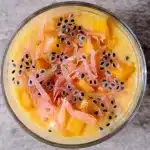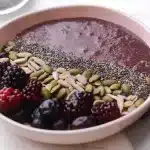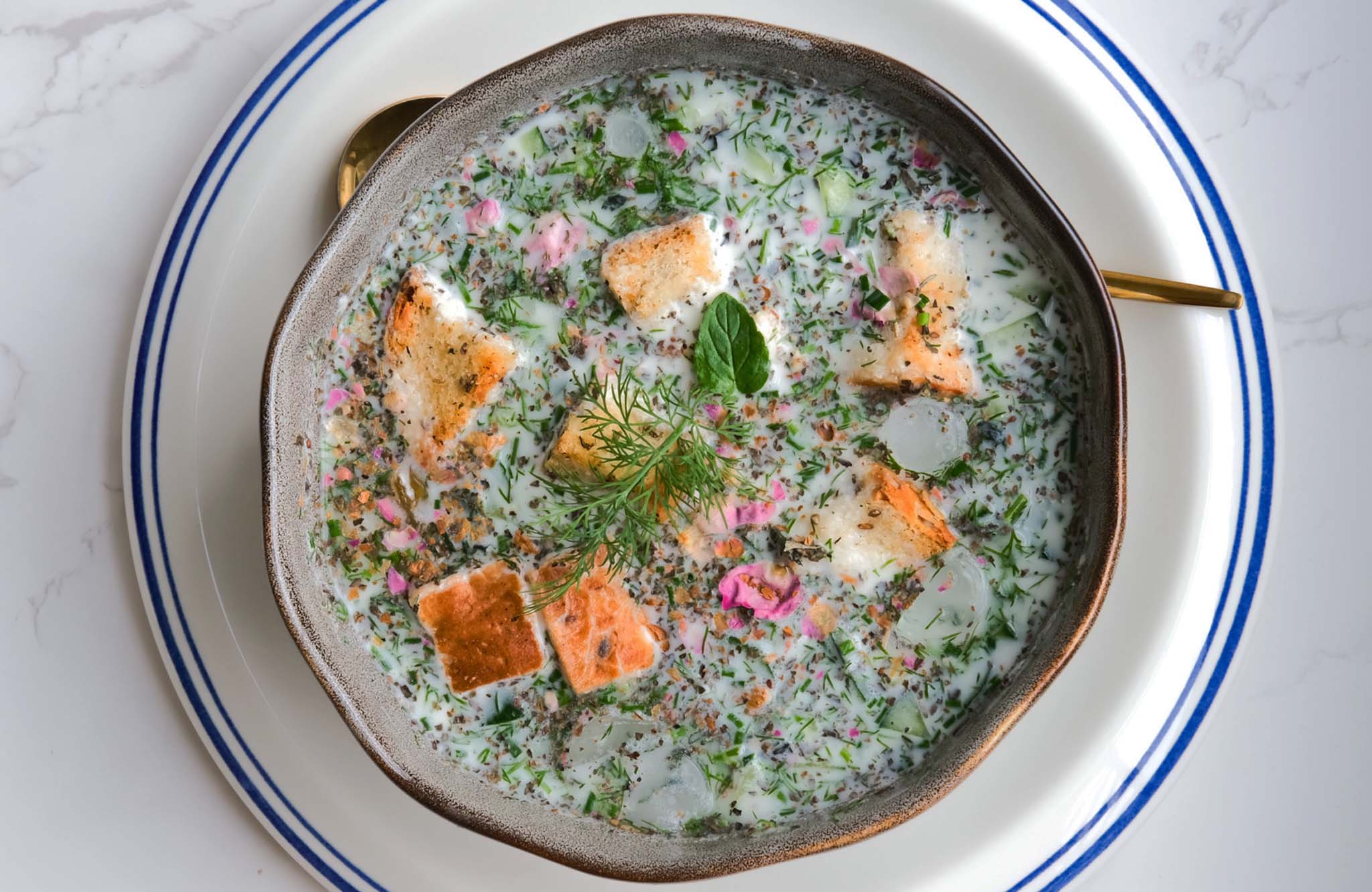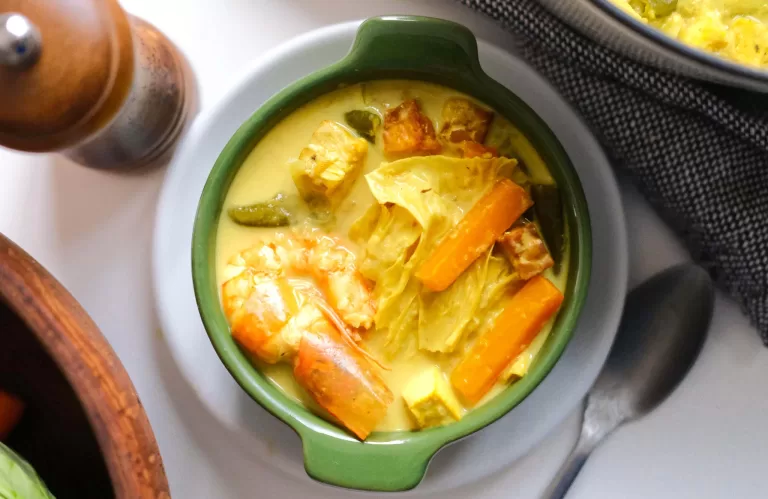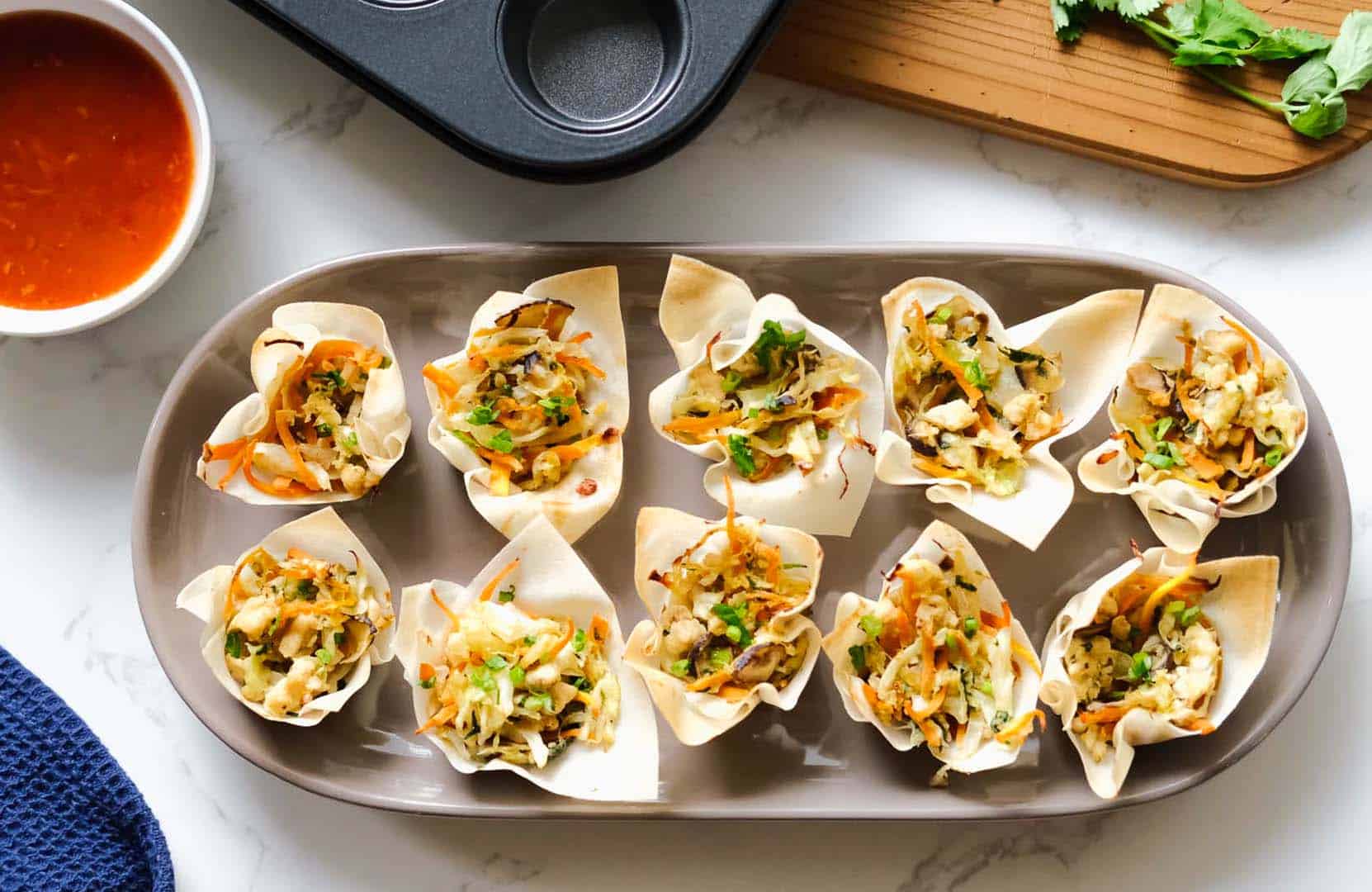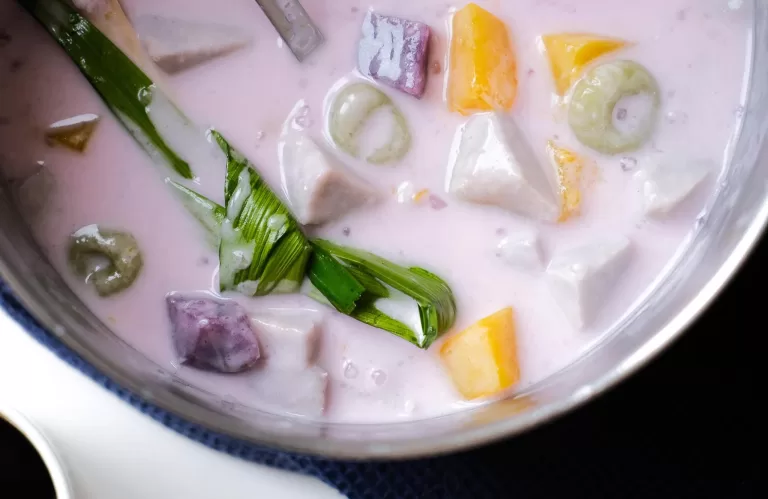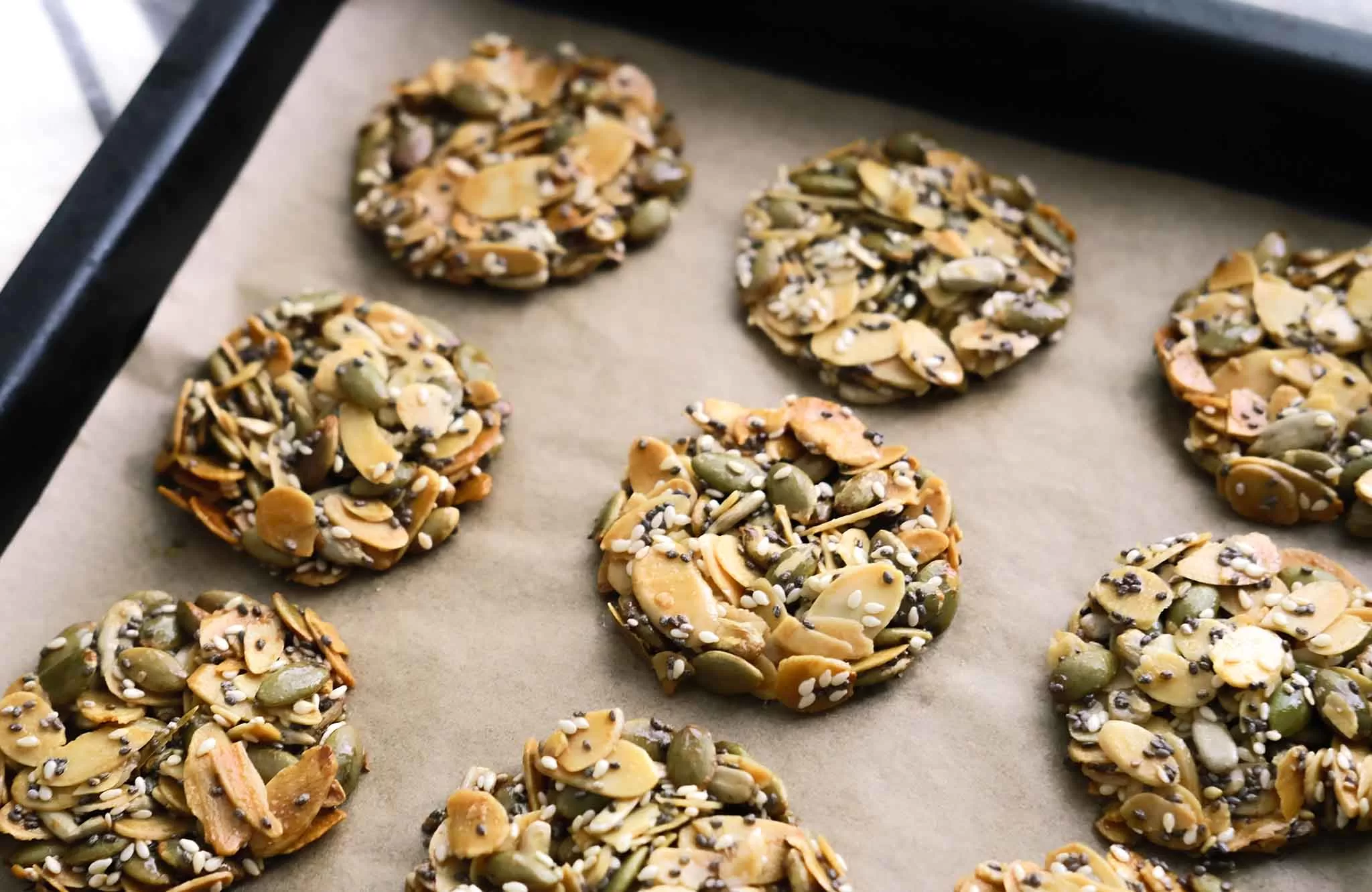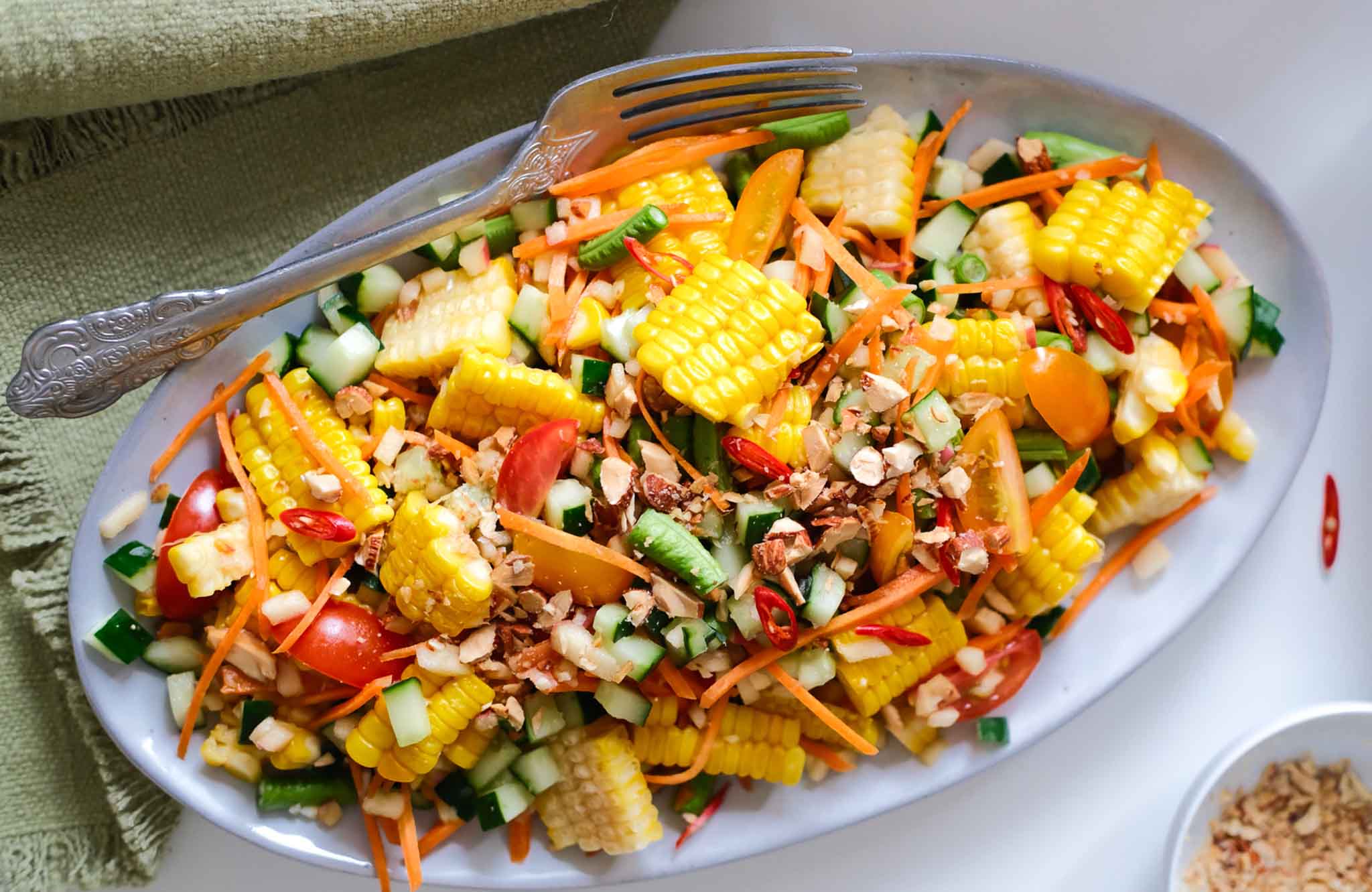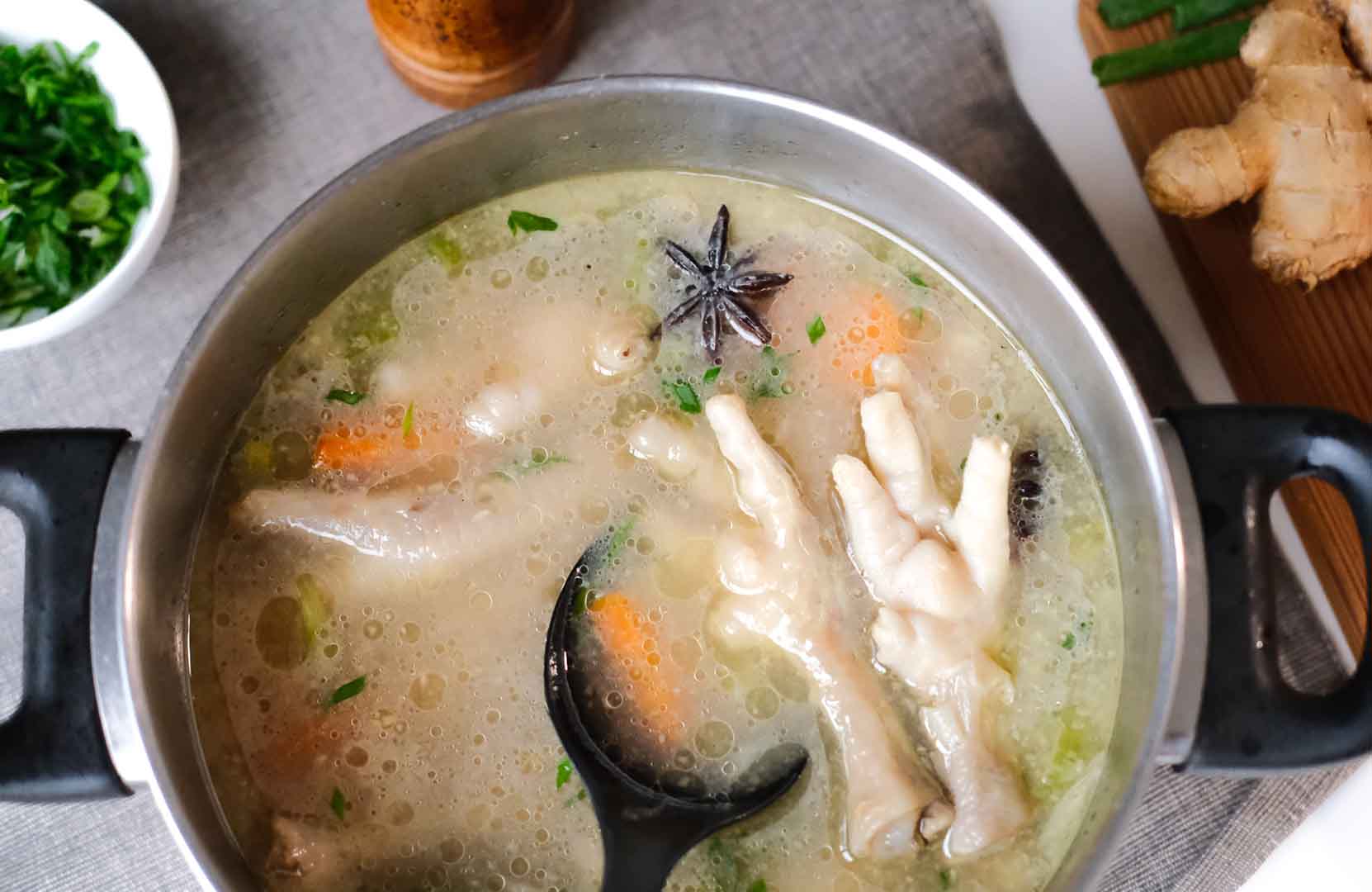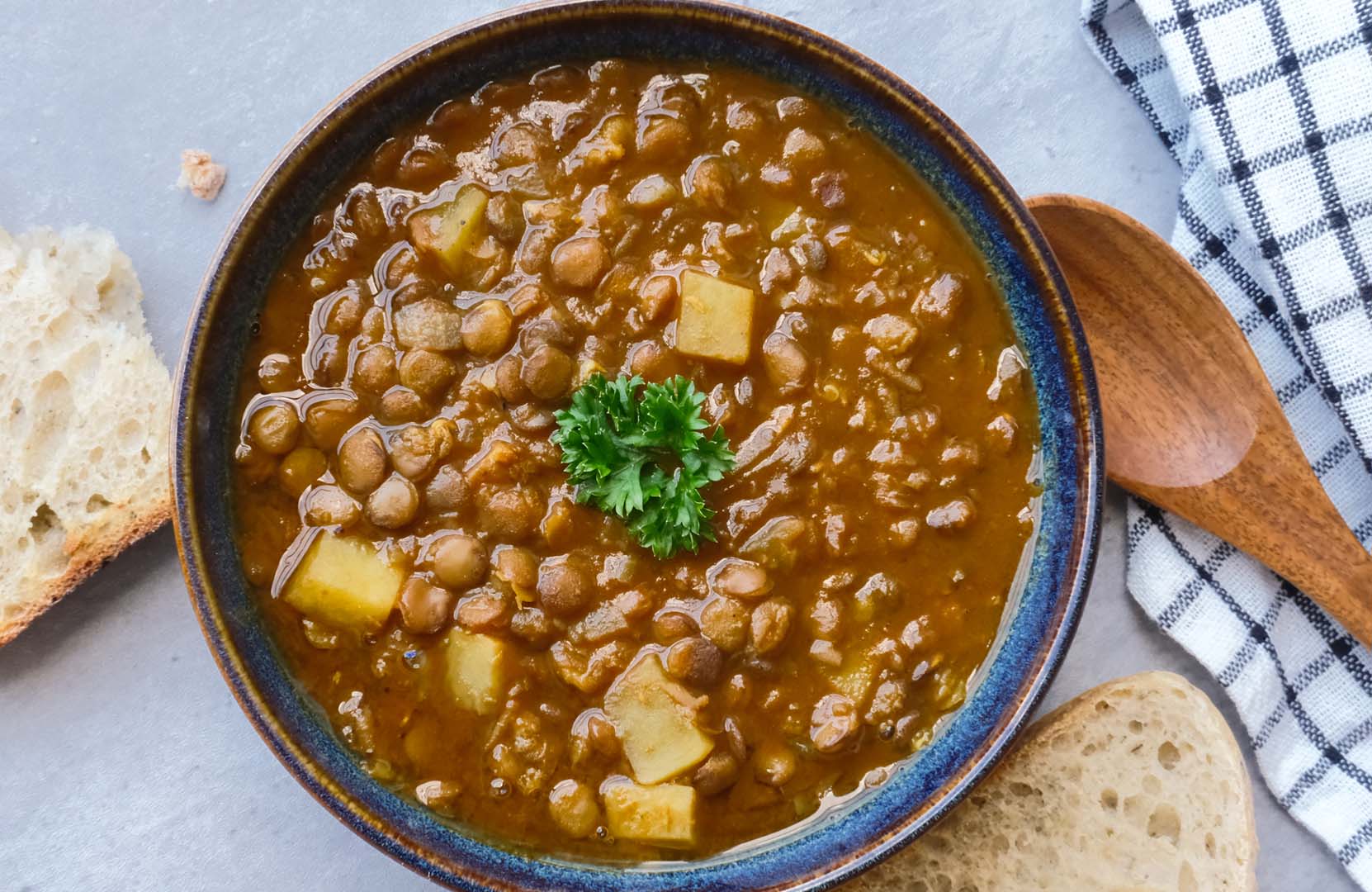Include these foods in your anti-inflammatory food grocery list, and it will help boost your nutrition intake and improve gut health. While everyone is trying to reduce inflammation through foods, knowing a bit about inflammation is essential.
Inflammation is part of the body’s defense mechanism (1). It can help protect your body. When inflammation stays in your body longer, that turns into chronic inflammation. Chronic inflammation is one of the reasons that affects people’s lives and can result in many deadly diseases.
I was diagnosed with early signs of arthritis in my 30s (a year ago), which is possibly linked to my existing inflammatory condition – Psoriasis. Although I had already been careful with my diet, I needed to improve my eating habits and lifestyle to control the inflammation.
Besides cutting most of the heavily processed foods, I have been incorporating foods high in antioxidants in my recipes for the anti-inflammatory benefits. I aim to eat for nutrition, reduce inflammation, and lower the chances of other diseases while enjoying the food that I make.
Antioxidants are substances that protect human cells from the damage caused by free radicals, which are often linked to diseases like diabetes, cancer, and other chronic diseases. More antioxidants in your diet may reduce inflammation and the chance of chronic diseases.
This list of anti-inflammatory foods is gathered based on my understanding from research, books, articles, and trusted sources I have collected over the years of my journey to healthy eating and reducing inflammation.
I am not a medical professional, just someone with inflammatory conditions who is trying to incorporate whole food high in antioxidants, minerals, and vitamins so I don’t have to rely on pills all my life. These foods have helped me feel better physically, mentally, and emotionally, and I hope they will be of good use to you too. But do consult with your doctor before making any changes in your diet and if you have concerns regarding specific foods.
What is anti-inflammatory food?
Anti-inflammatory foods are the ones rich in Vitamin C, Polyphenols (a compound with antioxidant benefits that help fight against chronic diseases), Omega 3 fatty acids, and foods that contain Probiotics (living microorganisms beneficial for our body) and Prebiotics (types of fiber that feed the microorganisms so they thrive and benefit our body).
Let’s dive into the list of the anti-inflammatory foods you can add to your cart! I’ve categorized it into food groups, so it helps you to grab several things from the list in the grocery aisle.
Fruits
Berries
According to many experts, berries are the best fruits you can have. Besides being delicious and low in sugar, these deeper and darker-colored fruits are high in polyphenols, contain prebiotics, high in fiber, and are rich in Vitamins C and K.
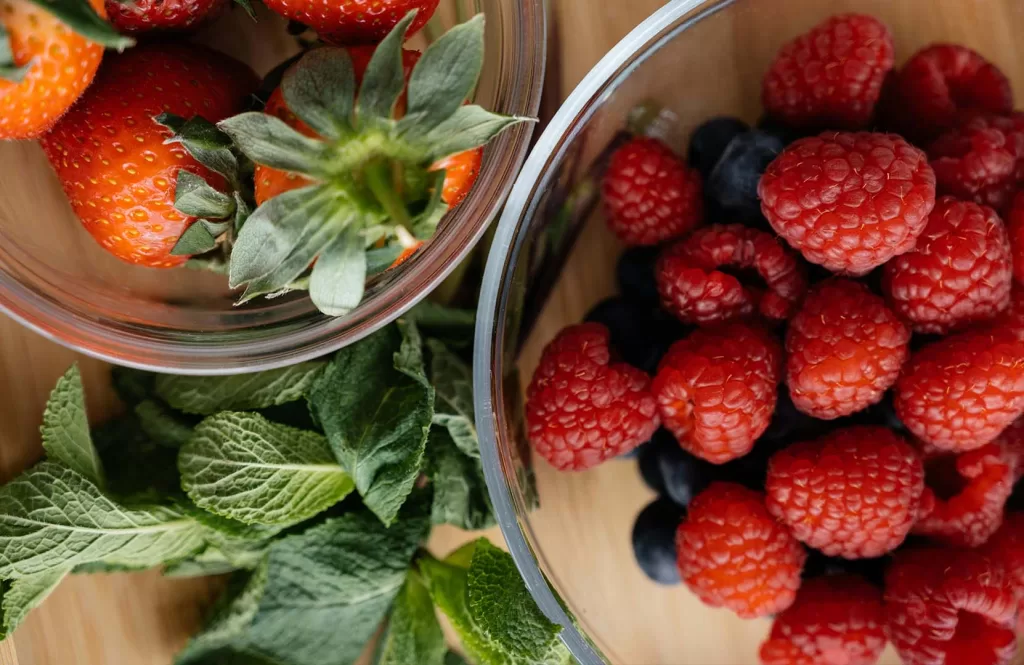
The polyphenols in berries, especially anthocyanins, have been proven to have anti-inflammatory effects (2). Many studies have shown berries are beneficial to various parts of our health, including heart (3), bones (4), and brain health (5). May help prevent cancer (6), are diabetes-friendly (7), may ease arthritis (8), and many more.
A Professor from Harvard’s T.H. Chan School of Public mentioned (9)
“On average, people who eat more berries seem to live a little bit longer”
List of berries and their antioxidant compounds:
- Strawberry – High in vitamin C
- Raspberry – Highest amount of fiber compared to other berries
- Blueberry – Contains the strongest total antioxidant capacity compared to blackberries & strawberries (10)
- Goji berries – Contains antioxidant zeaxanthin and vitamin A, beneficial for eye health
- Blackberry – High in potassium
- Bilberries – Have higher anthocyanin content compared to strawberries and raspberries (11)
- Açaí berries – High in antioxidants, which is 10x higher than blueberries (12)
- Grapes – Higher in sugar compared to other berries
So, having 2 or 3 cups in a week might be beneficial to your heart, as suggested by Dr Rimm from Harvard’s T.H. Chan School of Public (13). You can add them to your yogurt bowl, eat them alongside pancakes, or toss them in a smoothie.
Note that frozen berries are said to have similar benefits to fresh ones. Thanks to the invention of the refrigerator, we can eat berries all year without waiting for the berry season.
Dark leafy greens
Dark leafy greens are undoubtedly one of the healthiest foods we can add to our anti-inflammatory grocery list. They are rich in fiber, contain high amounts of A,C, K, E, and B vitamins, high in minerals – iron, potassium, magnesium, and calcium that are beneficial for overall health, including brain & bone health, protecting from inflammatory diseases and certain types of cancers (14).
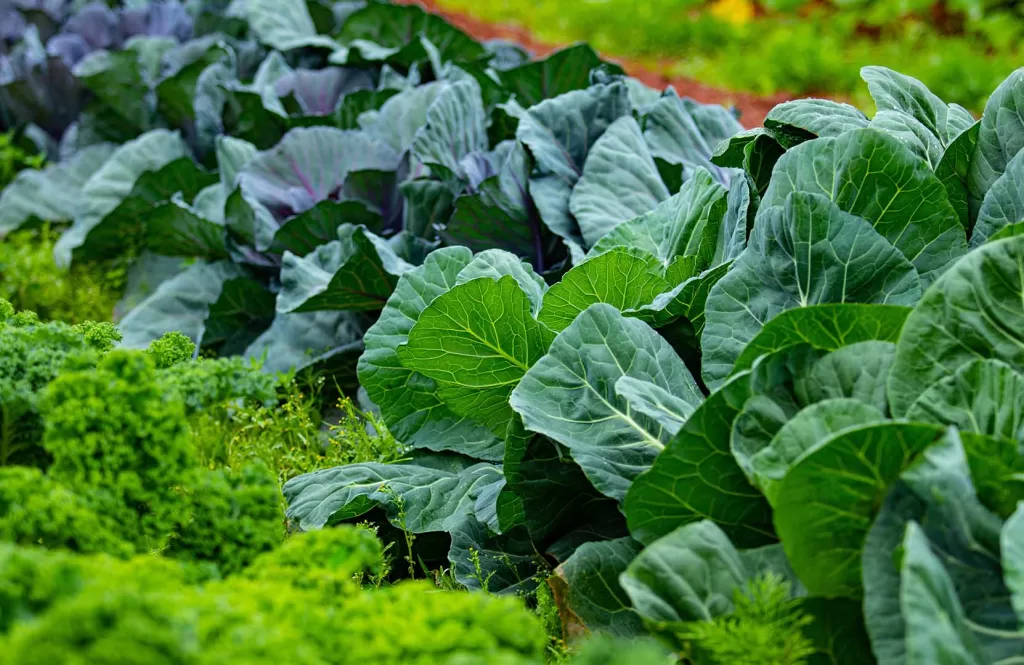
Dark leafy greens, especially spinach and kale, contain Kaempferol and quercetin – flavonoid antioxidants that are anti-viral, anti-bacterial, anti-fungal, anti-inflammatory, and cardioprotective properties(15).
Sprouts and microgreens, despite being small, are high in antioxidants and carotenoids (16) and may provide similar nutritional effects to matured greens (17).
List of dark leafy greens:
- Spinach
- Kale
- Collard – prebiotic
- Swiss Chard
- Mustard greens
- Turnip greens
- Sprouts & Microgreens
- Bok Choy
- Arugula
- Watercress
- Romaine lettuce
USDA recommends two to three cups per day, and to get the most nutrition, eat a variety of them. You can make green smoothies, add them to your soup, or toss them with other vegetables and oil massage with extra virgin olive oil.
If you don’t like the bitter taste of leafy greens, I have a post sharing 4 delicious anti-inflammatory salad dressings to help with your greens intake.
Cruciferous Vegetables
These family vegetables are famous for their health-boosting nutrients due to their Vitamins K, Folate, and phytochemicals that act as antioxidants. Like dark leafy greens, cruciferous vegetables are also high in fiber, and some contain prebiotics.
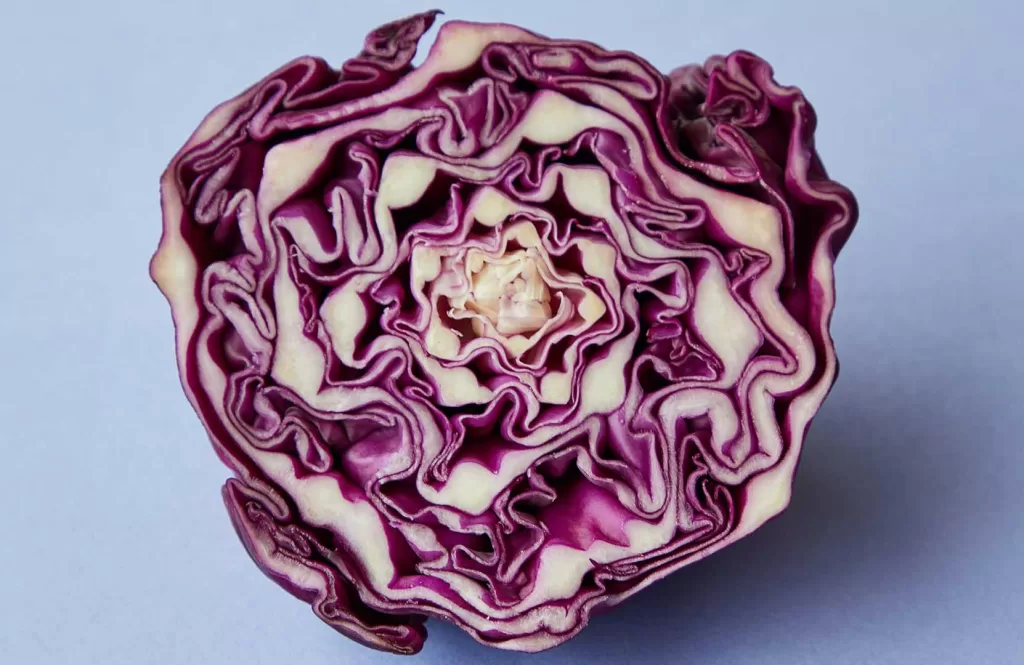
Few studies recommended that increased consumption of cruciferous vegetables may reduce the risk of chronic diseases such as cancer (18) and cardiovascular disease (19).
List of dark cruciferous vegetables:
- Brussels sprouts
- Kailan
- Broccoli
- Broccolini
- Cauliflower
- Cabbage
- Radish
Cruciferous vegetables are easy to cook with. Broccoli needs only 2-3 minutes to boil.
Cooking cruciferous vegetables at high power, especially through boiling and microwaving, may reduce the bioavailability of isothiocyanates, a chemical compound that is shown to help with cancer prevention (20)
You can also mix various vegetables with protein in a pan for stir-frying. Check my Turmeric & Black Pepper Chicken recipe here. You can also make Sauerkraut from cabbage to boost your probiotic intake.
Mushrooms
These ancient superfoods have been used by physicians for a long time to treat various diseases (21). Although being less talked about in the anti-inflammatory areas, mushrooms have many health-promoting benefits, especially in inflammatory conditions (21). The compounds such as polysaccharides, indoles, polyphenols, and carotenoids in mushrooms were shown to possess antioxidant, anti-inflammatory, and anticancer effects (22).

Mushrooms are good sources of prebiotics, fiber, protein, and vitamins such as D and Bs (folate) and are low in calories. Besides having many health benefits, mushrooms are loved in Asian countries due to the umami taste that adds a natural, earthy flavor to the foods.
List of anti-inflammatory mushrooms:
- Shitake
- Shimeji
- Lion’s mane
- Buttons
I have a few Asian recipes with shitake and shimeji mushrooms – check out these Vegan Tom Yum Soup and Chicken Tom Yum Soup recipes. Lion’s mane will be a good substitute for chicken due to the taste and texture if you are trying to reduce animal protein or a vegan.
Starchy vegetables
Starchy vegetables are complex carbohydrates – a type of carbohydrate that comes with fiber. Since fiber cannot be broken down for energy, it will benefit your blood sugar levels by slowing down the digestion process. In this sense, compared to simple carbs like rice, potatoes, and white bread, starchy vegetables are low in glycemic index.
Because of the high carb content, starchy vegetables are often put aside. But there is really no need to be afraid of a good complex carb as some of them can nourish your body.
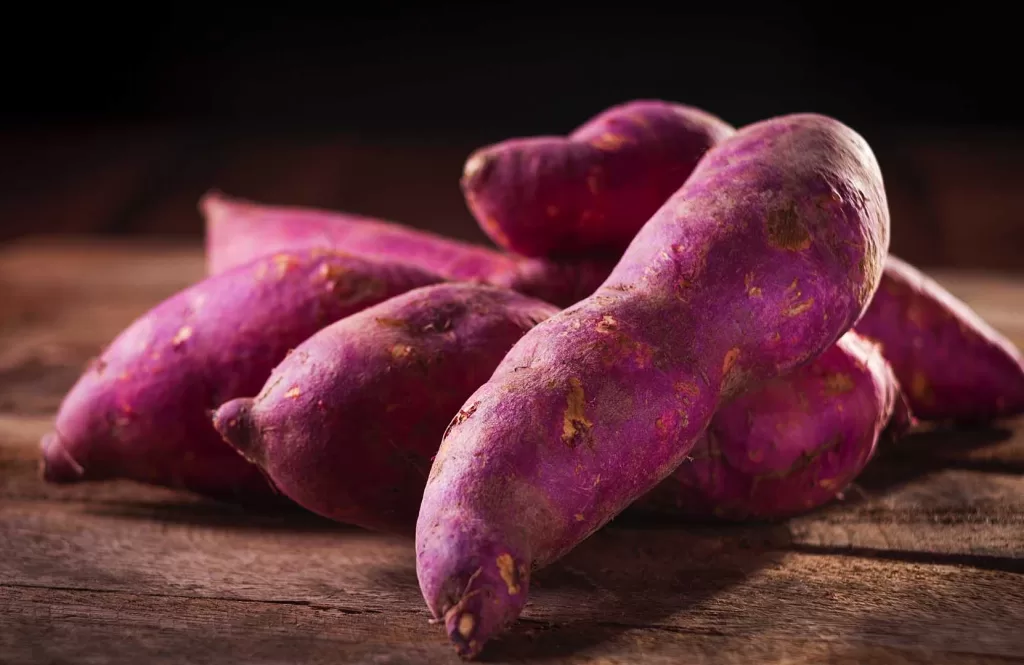
Orange and yellow flesh sweet potatoes and squash contain high levels of antioxidants like ascorbate and carotenoids (23). Carotenoids are one of the strong antioxidants to fight free radicals that can lead to chronic diseases (24).
Purple potatoes are the highest in antioxidants – Anthocyanins – Remember the same type found in berries? They also have additional polyphenolic compounds, such as chlorogenic acid and caffeic acid, than white potatoes (25).
Many studies have shown that purple-flesh potatoes with high amounts of polyphenols and anthocyanins are linked to health benefits such as anti-cancer (26) and anti-diabetes properties (27) and improving gut health (28).
The healthiest starchy vegetables
- Sweet potato
- Purple potatoes
- Pumpkin
Note that the anti-inflammatory effects of the sweet potato decrease in amount when cooking. The latest study in 2023 (29) found that steaming seemed to be the best cooking method to retain the antioxidant components and capacity of purple sweet potatoes.
Sweet potatoes are an excellent substitute for french fries, and my husband agreed with this. Whenever I crave french fries, I would make air-fried sweet potatoes coated with olive oil and cajun seasoning. It’s delicious and guilt-free!
Whole grains
Whole grains are a must in my grocery list as a source of carbohydrates. Since I cut refined carbs, I would alternate whole grains with starchy vegetables from time to time. Whole grains are another complex carbohydrate food high in phytochemicals like starchy vegetables.

They are high in fiber, phytochemicals, and minerals such as B vitamins, iron, copper, zinc, and magnesium (30). If you take refined grains like white rice, white bread, and pasta on a daily basis, swapping them for whole grains can benefit different parts of your health.
The phytochemicals compounds in whole grains can benefit our bodies in:
- Maintaining steady blood sugar – lowers the risk of type 2 diabetes (31)
- Lower cholesterol, hence preventing cardiovascular diseases (32)
- May protect against chronic diseases like cancer (33)(34)
- Increase digestive health as they contain prebiotic
These are among the most beneficial whole grains with carbohydrate and other nutrient content per 100g, according to USDA (except for the anti-inflammatory compounds).
| Whole Grains – raw | Calories (kcal) | Protein (g) | Carbs (g) | Fiber (g) | Anti-inflammatory compounds |
|---|---|---|---|---|---|
| Rolled Oats | 382 | 13.5 | 68.7 | 10.1 | Lutein, zeaxanthin |
| Quinoa | 368 | 14.1 | 64.2 | 7 | Beta Carotene |
| Buckwheat | 356 | 11.1 | 71.1 | 4 | Quercetin, Rutin, flavone C-glucosides |
| Brown rice | 366 | 7.25 | 76.7 | 4.3 | Anthocyanins |
| Farro | 362 | 12.8 | 72.3 | 10.6 | Polyphenols, carotenoids, selenium |
| Sorghum | 329 | 11 | 72 | 7 | Anthocyanins and Phenolic acids |
The easiest food you can make is using rolled oats. Oats are suitable for a wide variety of foods, breakfast food, snacks, soups, and desserts. If you have a sweet tooth, I have one dessert recipe you can try – Guilt-free Gingerbread Bundt Cake. Another easy way you can consume oats is by making granola and overnight oats.
My second favorite grain is brown rice, which I take almost every day with other mains. If you are into multigrain or perhaps trying to increase your whole grain intake, check out my Korean Multigrain Recipe using brown rice and other whole grains cooked in a rice cooker.
Legumes
Legumes are one of the best sources of plant-based protein. In the Mediterranean diet, legumes are consumed daily in moderate proportions. Another part I like about legumes is that they are complex carbohydrates with high fiber that also keep you full while being high in nutrients.
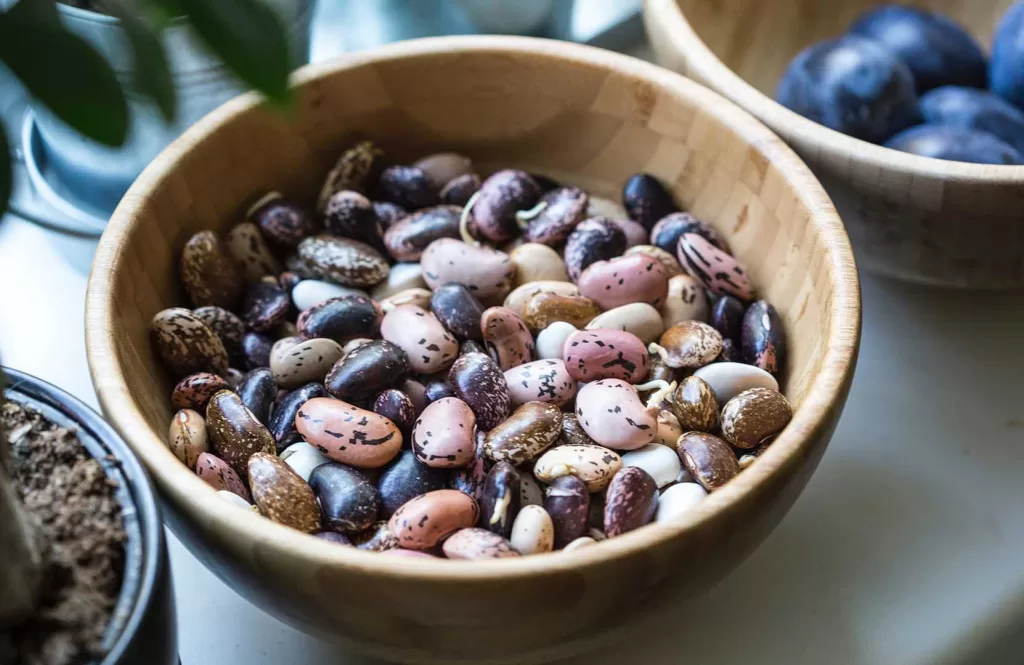
Legumes are a powerhouse of minerals such as iron, magnesium, potassium, chromium, copper, selenium, manganese, zinc, and phosphorous, folic acid, and it is shown to exhibit many health benefits, including cell growth, production of energy, nerve and muscle function (35).
These are the anti-inflammatory legumes and the amount of calories, protein, and carbs per 100g, according to USDA.
| Legumes – raw | Calories (kcal) | Protein (g) | Carbs (g) |
|---|---|---|---|
| Beans – Kidney | 337 | 22.5 | 61.3 |
| Lentils | 360 | 22 | 68 |
| Chickpeas | 383 | 21.3 | 60.4 |
| Black beans | 341 | 21.6 | 62.4 |
| Soybean | 446 | 36.5 | 30.2 |
This article from Harvard (36) suggests eating at least three servings of legumes a week if you are adopting the Mediterranean diet. If you are worried about the antinutrient content in legumes, you can soak, boil, ferment, or sprout them to lower the antinutrient effect.
Sprouting not only reduces the phytic acid (37) and lectins (38) but also enhances the absorption of minerals and vitamins (39). Check this article from Healthline on how you can prep the legumes to reduce the antinutrients (40).
Also, check my family’s recipe Persian Lentil Soup, Persian lentil rice, and Multigrains Rice using beans and chickpeas.
Fat – Unsaturated
In the Mediterranean diet, fat is taken regularly. And yet, this diet is considered the healthiest. This baffled me at first, coming from a country where fat is considered unhealthy, until I learned the difference between fats.
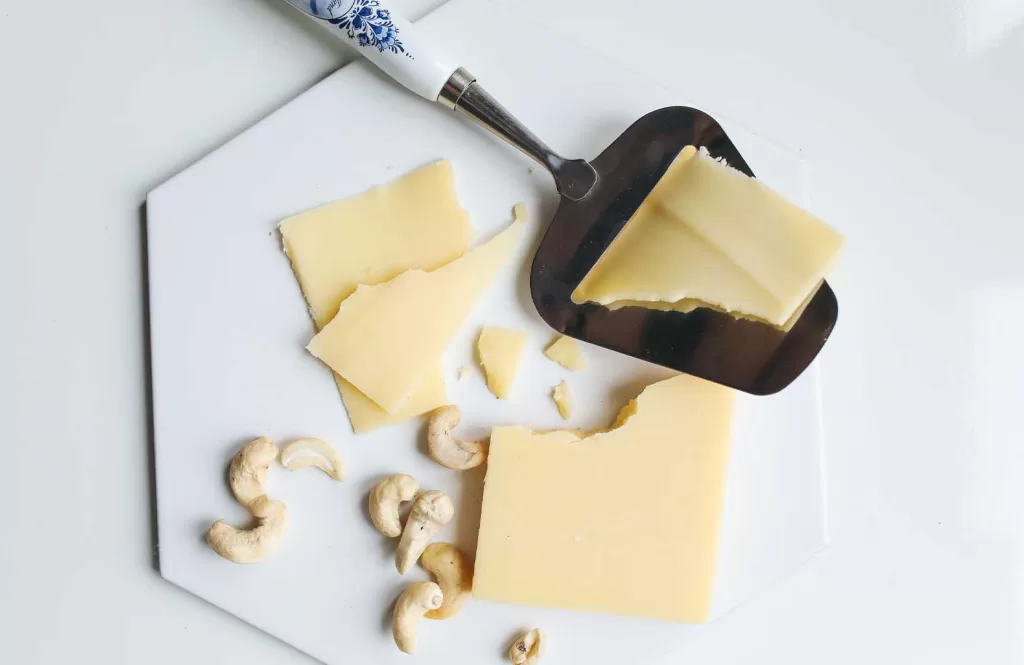
There are trans fat, saturated fat, and unsaturated fat. Trans fat is highly processed and, therefore, the unhealthiest type of fat that we need to avoid. Saturated fat, which is mainly animal-based (in a solid form), is the one we need to take sparingly. And then the healthy one, which I’m going to focus on is unsaturated fat.
Unsaturated fat is beneficial to our body, including improving blood cholesterol levels, easing inflammation, and stabilizing heart rhythms. In contrast, Saturated fat is the type of fat we need to be cautious of due to the high cholesterol levels that could potentially cause cholesterol-related problems if taken in excess.
Unsaturated fat consists of two types differentiated by the bonds in its chemical structure – Monounsaturated and polyunsaturated fat. Polyunsaturated fat supplies 2 types of fatty acids, which are Omega 3 and Omega-6.
Omega 3 is shown to possess a high antioxidant effect that can benefit inflammatory conditions, while the opposite is commonly linked to omega 6, although more study is needed to prove this.
Below, I created a visual to help you understand this part. The ones highlighted in green are the anti-inflammatory fats.
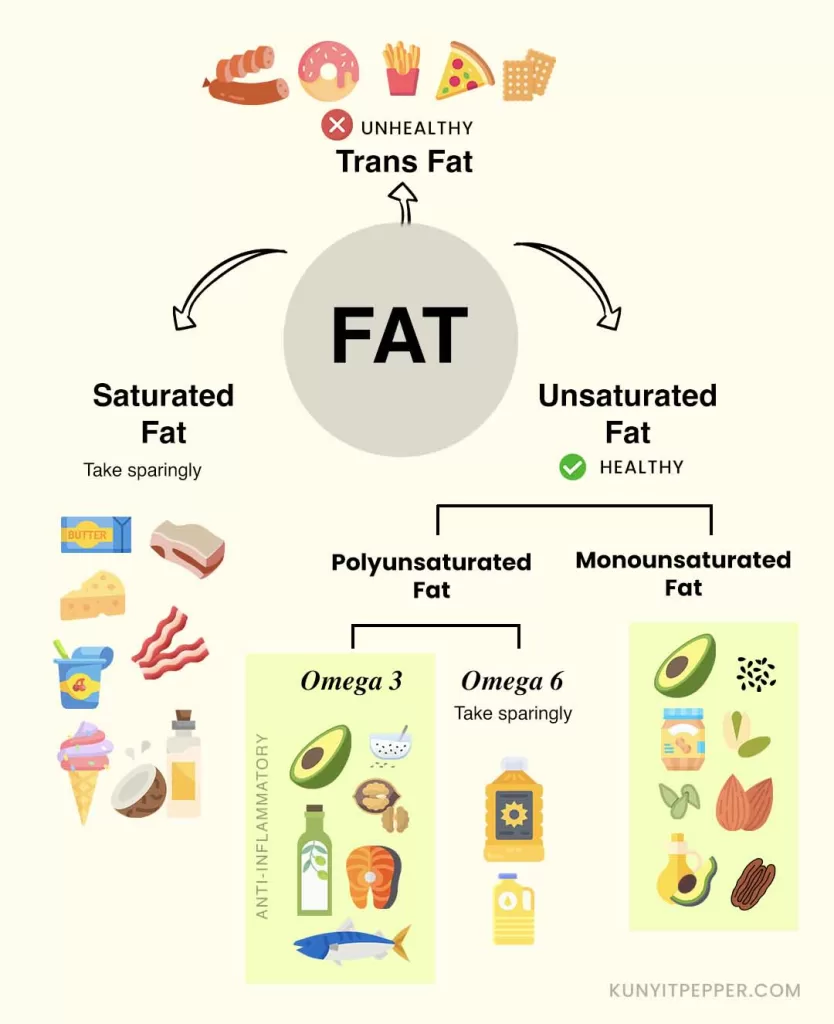
List of anti-inflammatory unsaturated fat
Monounsaturated fat
- Avocados
- Extra virgin olive oil
- Nuts
- Nut butter
- Pumpkin seeds
Polyunsaturated Omega-3 fat
High-fat fish
- Salmon
- Sardines
- Mackerel
- Herring
- Trout
Seeds
- Chia seeds
- Flax seeds
Nuts
- Walnut
Herbs & Spices
Since I have reduced the use of condiments in my foods, my herbs and spices rack requires top-off quite regularly. They are amazingly healthy and flavorful swaps to highly processed condiments in spicing up meals.
Herbs and spices have been used in both culinary and medicine since ancient times. Today, there are several evidence showing the benefits of herbs and spices, especially in antioxidant, anti-inflammatory, anti-cancer, blood sugar, and cholesterol-lowering activities, as well as positive effects on cognition and mood. (41)(42)(43)
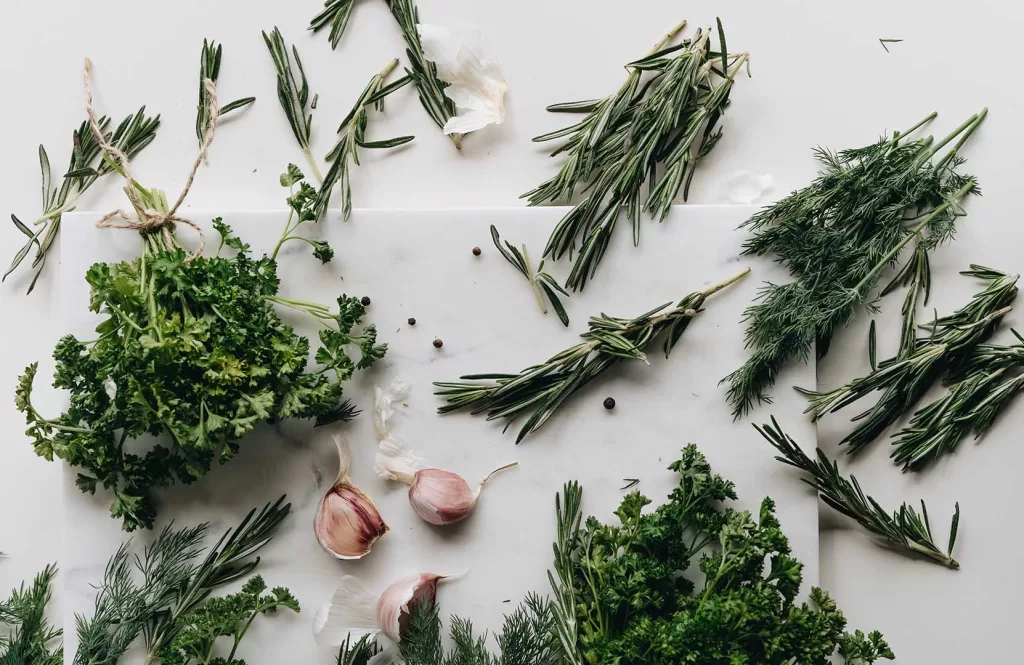
Thanks to its polyphenols and flavonoid compounds. Incorporating both Mediterranean and Asian spices can offer a wide variety of anti-inflammatory benefits. Here’s the list of herbs and spices with active anti-inflammatory compounds.
Refer to this article (44) on the link between spices, chronic diseases, and inflammation to see detailed info and evidence of the active compound of the spices.
List of herbs with their antioxidants and anti-inflammatory compounds:
Mediterranean
- Basil – Eugenol, Rosmarinic acid
- Rosemary – Carvacrol, Rosmarinic acid, Carnosol
- Thyme – Thymol, Luteolin
- Oregano – Carvacrol, Thymol
Asian
- Turmeric – Curcumin
- Black pepper – Piperine
- Ginger – Gingerols
- Onions – Quercetin, Allicin
- Garlic – Allicin, Diallyl sulphide
- Ginseng – Ginsenoside
- Clove – Eugenol
- Lemongrass – Citral
- Cayenne – Capsaicin
- Ginger Torch – Phenolic, Flavonoid
- Cinnamon – Cinnamaldehyde
- Cumin – Thymoquinone
- Coriander – Vitamin C, Carotenoids, Flavonoids
- Peppermint – Menthol, Rosmarinic acid
- Cardamom – Cineole
- Sumac – Gallic acid, Ellagitannins
- Saffron –Crocetin, Flavonoid (quercetin, kaempferol)
Tea
Polyphenols are the main active compounds in teas (45), making them the healthiest drink to get the antioxidant effect from. Green and black tea are linked to having beneficial effects in fighting against cardiovascular diseases, particularly atherosclerosis and coronary heart disease (46).
Herbal teas contain phytochemicals, minerals, and vitamins that are beneficial to overall health. Apart from giving a sense of calmness, some herbal teas may also help reduce pain in muscles (47) and menstrual cramps.
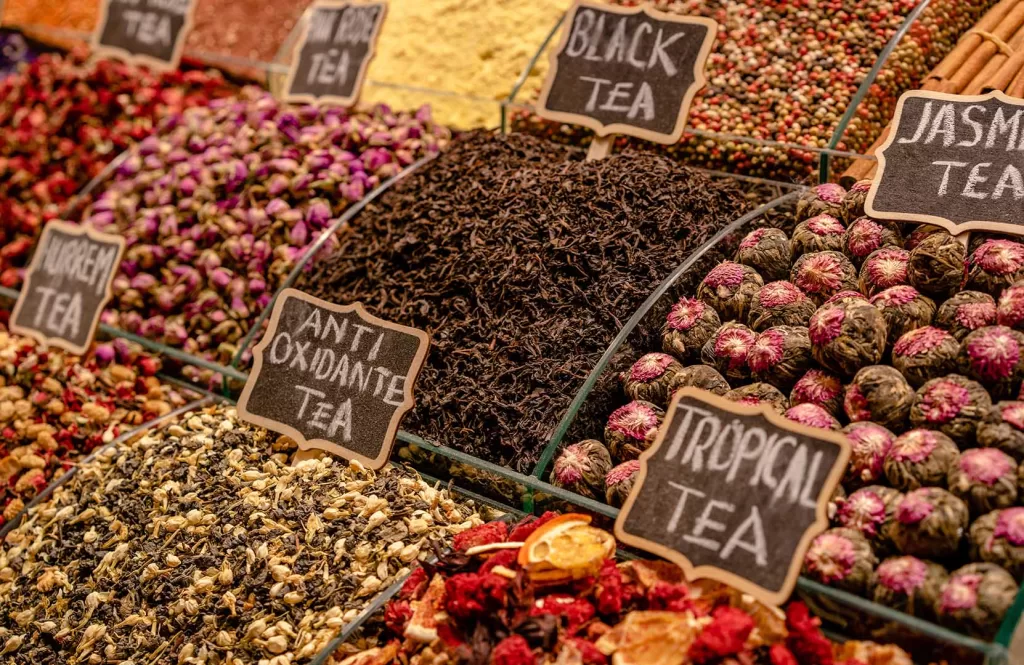
Green tea, especially, has shown anti-inflammatory effects in many studies (48). Thanks to its polyphenols – mainly catechins that have been shown to have a protective effect against cancer, diabetes, neurological, and cardiovascular diseases.
List of teas with their antioxidants and anti-inflammatory compounds:
- Green tea – Catechin -E GCG
- Ginger tea – Gingerol, Paradols & Shogaol
- Lemongrass tea – Citral, Geraniol
- Ginseng tea – Ginsenosides
- Turmeric tea – Curcumin
- Chamomile tea – Apigenin
- Peppermint – Rosmarinic acid – a compound also found in other Mediterranean herbs such as rosemary, sage, lemon balm mint, and sweet basil
- Rosehip – Vitamin C, gallic acid & quercetin
- Hibiscus – Anthocyanins, Hibiscus acid
- Macha – Catechins
- Oolong Tea – Theaflavins & thearubigins – primary polyphenols in black tea
- Holy basil – Rosmarinic acid, Eugeno
A recent study (2022) (49) in the UK has shown that drinking tea reduces the risk of death – Annals of Internal Medicine.
In conclusion, consuming different varieties of whole foods high in antioxidants, vitamins, and minerals can benefit our bodies in many aspects, including reducing the chance of chronic diseases.
These anti-inflammatory foods may or may not benefit you the same way. Different people react differently to foods depending on many things like medical conditions, genetics, etc. Do consult with your physician if you have a concern about the ingredients.
I hope you now get the list for your next anti-inflammatory grocery shopping! All the best to your cooking! Let me know in the comments below if the list is helpful to you, and perhaps if you have more ingredients you can contribute to my grocery list, I appreciate the sharing.



